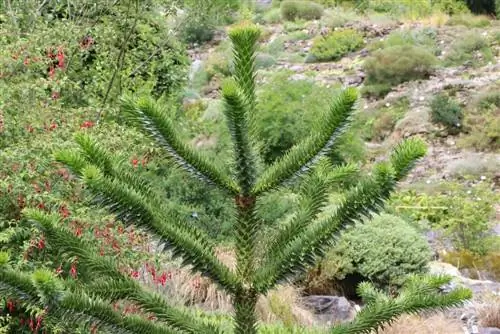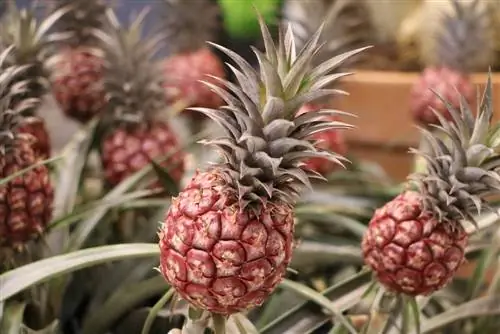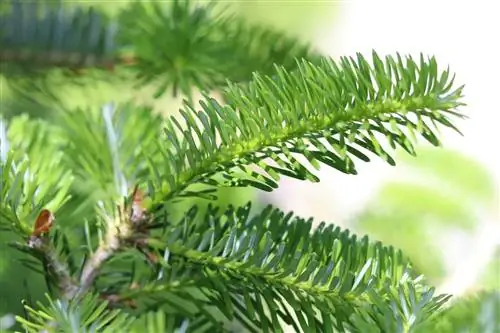- Author admin [email protected].
- Public 2023-12-17 03:39.
- Last modified 2025-06-01 06:48.
Andean fir, Chile fir, snake tree, scale fir, or monkey tree - the ornamental fir has many names. It is well known in garden centers and tree nurseries and can also be discovered more and more often in front gardens. Here, however, it requires optimal care.
General
The ornamental fir grows very slowly and is usually between 10 and 30 cm high. In Germany, as a small tree, it grows between 5 to 10 meters high and three to four meters wide. In particularly good locations, however, the ornamental fir can grow up to 25 meters high. In protected front gardens, the ornamental fir can become a nuisance; female trees in particular can become large and sprawling; male trees tend to remain small and low.
The decorative fir impresses with its unusual needles or leaves. The piercing, broadly triangular needles or leaves are arranged spirally on the branches. The branches are arranged horizontally in a circle on the trunk of the ornamental fir, which means that new levels are constantly being created on the tree. This can be seen particularly well in young ornamental firs. The ornamental fir is an exotic, hardy eye-catcher in home gardens and very popular with hobby gardeners.
Care
Flowers
The decorative fir only bears flowers after many years, usually in the thirtieth year. Flowering time is in summer from July to August. A special feature is that the ornamental fir tree has male and female trees. The flowers of female trees stand upright on the branches as 15 cm large spherical cones; in male trees, cylindrical cones hang on the branches. After one to three years, the cones disintegrate and release the ripe seeds. The seeds of the ornamental fir are up to 4 cm long and are even edible; the Indians already valued the seeds of the ornamental fir as a particularly protein-rich food.
Location
The ornamental fir prefers very bright and sunny locations. The soil should be slightly permeable but still moist, slightly acidic and moderately rich in nutrients. Waterlogging must be avoided at all costs. The plant does not tolerate transplanting in the meantime particularly well. In particular, the risk of injuring the roots is quite high. Anyone planning to plant a Chilean ornamental fir soon will certainly find it interesting that they are adding one of the oldest living plant species to their garden.
Special features
The ornamental fir must not stand dry during the growing season. The ornamental fir needs to be watered abundantly and regularly. Important: Avoid waterlogging at all costs, so only water when the top layer of soil is dry again. The decorative fir therefore tolerates dryness rather than wetness. As long as the ornamental fir is still in a plant pot, it should be fertilized every 2 - 3 weeks with a commercially available fertilizer.
Wintering
The young decorative fir does not tolerate frost particularly well, so we recommend good frost protection or overwintering in a planter in a frost-protected place. Older ornamental firs are hardy down to -15 °C, but these low temperatures should not last too long. In general, the ornamental fir is sensitive to the winter sun in winter.
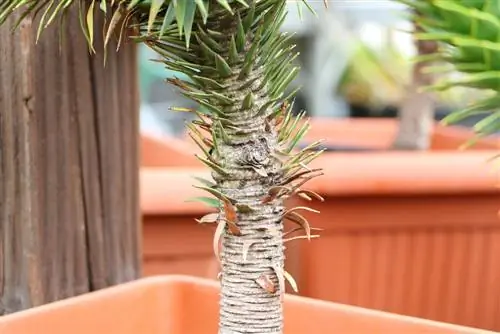
Longer periods of frost can affect the ornamental fir tree. It is very sensitive to cold frost and simultaneous winter sun. Unfortunately, evaporation occurs while the ground is still frozen and cannot absorb water. In the worst case scenario, the entire tree dries up or individual leaves (needles) may die. In Germany it is therefore more advisable to plant the ornamental fir on the north side of the garden. In addition, you can protect the ornamental fir by attaching a thick layer of straw to the trunk, which prevents the ground from freezing completely.
In winter you should check the ornamental fir regularly and keep an eye on it. The ornamental fir is usually kept in a planter when it is young so that the tree can be brought into the house to overwinter. After a relatively long period of time, the ornamental fir bears flowers and is even relatively easy to propagate. As an endangered species, the ornamental fir is protected in its homeland and can be found almost exclusively in the national park.
Propagation
The decorative fir reproduces by sowing seeds in late autumn. The only thing to note is that the seeds must never be dry and can only withstand frost down to -15 °C. So sow the seeds immediately after they have ripened. You can also overwinter the seeds in moist sand in a plastic bag in the refrigerator. Please store seedlings in a bright place.
Age
In your homeland there are said to be trees that are up to 1,000 years old. It is therefore worth considering whether you want to plant this beautiful exotic tree in your home garden as the tree is extremely long-lived. In old age, the ornamental fir tree is free of branches high up.
Diseases
The ornamental fir is very sensitive to waterlogging, which manifests itself in brown needles and the tree is usually already affected by a fungal disease. Once attacked by a fungus, the ornamental fir can no longer be saved; the fungus attacks the roots and causes root rot, which sooner or later leads to the death of the tree. Therefore, waterlogging must be avoided at all costs. Therefore, water less rather than more.
What you should know in brief
You've probably seen an ornamental fir before. The unusual shape of the tree, which can often be found in urban parks or separately in front gardens, easily attracts curious glances. Broad, flat leaves are typical of the ornamental fir, whose almond-shaped seeds are also pretty to look at.
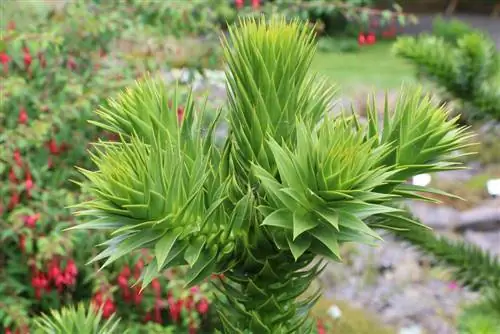
The ornamental fir, which goes under the botanical name Araucaria araucana, is commonly found in northwestern Europe. The species, also known as the Andean fir or monkey tail tree, originally lives in warmer climes. So it actually comes from Chile. What is particularly striking, as described at the beginning, is the strange, almost bizarre shape compared to other fir trees. However, it is precisely the extravagant look of the ornamental fir that makes it a popular tree in this country. The pretty fir, which is often planted individually, is related to the indoor fir.
- The Andean fir is slightly more expensive than comparable firs of the same size. Extravagance has its price. Smaller specimens (25 to 30 cm) of the ornamental fir are offered in local garden centers or online stores for around 30.00 euros.
- Larger monkey tail trees that measure around 50 to 60 cm are available from specialist retailers for around 75.00 - 85.00 euros.
- If you decide on a small tree, you should first consider that the Andean fir grows quite slowly. 30 cm per year can be seen as a guideline. Nevertheless, a lot of space must be taken into account when planting the ornamental fir, as it can grow to be between 10 and 15 meters high.
- well-drained soil
- Avoid waterlogging at all costs.
- Protect from frost and winter sun in winter
- water less rather than more
- As long as the decorative fir is grown in a bucket, fertilize it every two to three weeks with a commercial fertilizer
- young trees are not hardy

